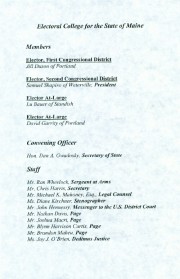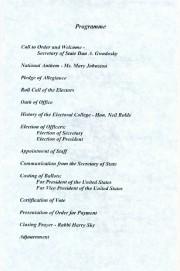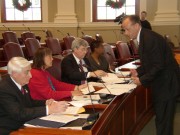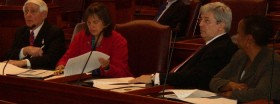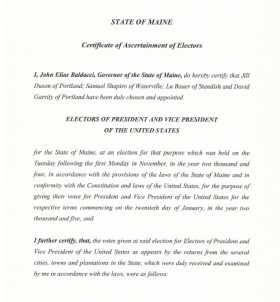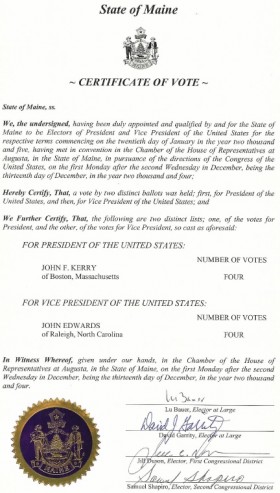Unlike state elections, the popular vote for President and Vice President of the United States does not directly determine the winners. The final determination is made by a group of 538 people distributed among the fifty states, based on the number of U.S. Senators and U.S. Representatives each has. A majority of 270 electoral votes is necessary to win.
Federal law, and Maine law, requires the electors of winning candidates to meet on the first Monday after the second Wednesday in December of the presidential election year to cast their votes. These electoral votes are then communicated to the U.S. Congress, which formally counts them in January and proclaims the official winners.
Program for the 2004 convention of the Maine Electoral College
Maine has four presidential electors since it has two U.S. Senators and two U.S. Representatives. They are nominated by political parties fielding presidential candidates, or by the candidates themselves if they are not enrolled in a political party, the so-called “independents.”
During the 2004 election, for example, all candidates for election were the nominees of political parties and each party nominated four electors.
In most states, the statewide winning candidates gain all of the state’s electors, who then vote for those winning candidates. In Maine however, for elections beginning in 1988, the statewide winner is guaranteed two electors, but the other two are distributed based on the winners in each of the state’s two congressional districts.
Thus, a presidential candidate might win all four or only three electoral votes, with the runner-up in the popular vote possibly winning one of the two congressional districts. In an unlikely situation, the statewide winner might earn only two electoral votes, and two other candidates could earn one vote each:
| Candidate | Statewide | 1st District | 2nd District | Electors |
| Smith | 310,000 | 155,000 | 155,000 | 2 |
| Jones | 180,000 | 160,000 | 20,000 | 1 |
| Bernier | 180,000 | 20,000 | 160,000 | 1 |
Since 1888 presidential candidates won pluralities statewide and in both congressional districts until 2016 when the Clinton campaign won statewide and in the first congressional district, but the Trump campaign won in the second district. As a result the state’s four electoral votes were split 3-1 for the first time.
A Certificate of Ascertainment lists the:
- names of the electors chosen by the voters and the number of votes received
- names of all other candidates for elector and the number of votes received
The Governor of each State prepares seven original Certificates of Ascertainment listing the persons appointed as electors as soon as possible after the November election.
- Each certificate must be signed by the Governor and carry the seal of the State.
- One of the seven original Certificates of Ascertainment, along with two certified copies (or two additional originals) must be sent by registered mail to the Archivist of the United States.
- Federal law does not govern the general appearance of the Certificate of Ascertainment.
- The remaining certificates are paired with the Certificates of Vote at the Meeting of Electors in December.
Certificates of Vote are the documents that contain the elector’s votes for president and vice president. While Federal law does not govern the general appearance of the certificates, they must contain two distinct lists – one for President and one for Vice President.
The electors must execute six Certificates of Vote. Each of the six certificates must be signed by all of the electors and a Certificate of Ascertainment must be attached to each of the Certificates of Vote.
The Certificates of Vote must list:
- all persons who received electoral votes for President and the number of electors who voted for each person.
- all persons who received votes for Vice President and the number of electors who voted for each person.
Finally, each of the six pairs of Certificates must be sealed and certified by the electors as containing the list of electoral votes of that State for President and Vice President. The Certificates are then sent to the designated Federal and State officials.
Source for Electoral College Procedures: National Archives



